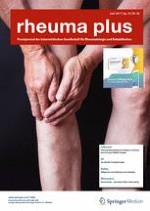Anzeige
01.06.2017 | JIA
Aktuelle Therapie der polyartikulären Verlaufsform der juvenilen idiopathischen Arthritis
Erschienen in: rheuma plus | Ausgabe 2/2017
Einloggen, um Zugang zu erhaltenZusammenfassung
Die Polyarthritis ist mit ca. 20 % die dritthäufigste Verlaufsform der juvenilen idiopathischen Arthritis (JIA). Die Polyarthritis ist aber Ursache eines bedeutenden Teils der Krankheitslast und der Langzeitprobleme der JIA. Etablierte Therapieformen mit Steroiden und konventionellen „disease-modifying anti-rheumatic drugs“ (DMARDs) sind in den vergangenen Jahren insbesondere durch die Zulassung neuer Biologika erheblich erweitert worden. Die aktuellen Therapiemöglichkeiten werden hier dargestellt.
